
The launch site at Wenchang Spaceport buzzed with activity on 23 July 2020. The launchpad was a mammoth rocket; named the Long March V, CNSA’s heavy-lift launch vehicle.
The rocket carried within itself a 3.1-ton orbiter and 0.2-ton rover, which would go on to traverse through the inner solar system on a lonely journey for more than 309 days before reaching their ultimate destination, Mars: the Roman God of War, earning China the distinction of being the first Asian country to successfully land on Mars.
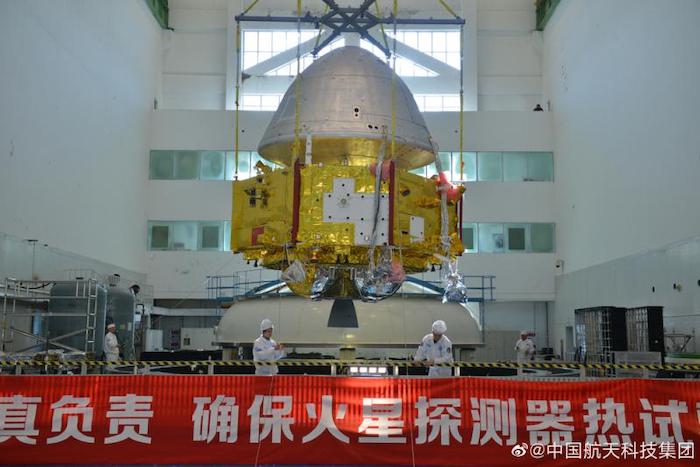
Tianwen -1 in a laboratory (Image Credit: english.cas.cn)
China’s rise in the global space race has been phenomenal despite being a late entrant to the league. With a huge industrial base, China has leveraged its technological prowess to propel itself into the ‘Elite Space Club.’
Despite not being its first attempt at Mars, China now has the distinction of being the ‘first and the only Asian nation to have soft-landed on Mars’.
Yinghuo – A failed attempt
In collaboration with Russia, China’s first attempt to Mars was the Yinghuo-1, an orbiter that was supposed to piggyback on the Fobos-Grunt: a Russian sample return mission to Mars and its moon.
Apart from this, the mission also carried a payload from the Bulgarian Academy of Sciences and the American Planetary Society. Launched aboard the Zenit – 2SB41 in November 2011 from the Baikonur Cosmodrome, the mission failed when the Fobos-Grunt’s Main Propulsion Unit failed, preventing it from moving any further from its initial Earth parking orbit.
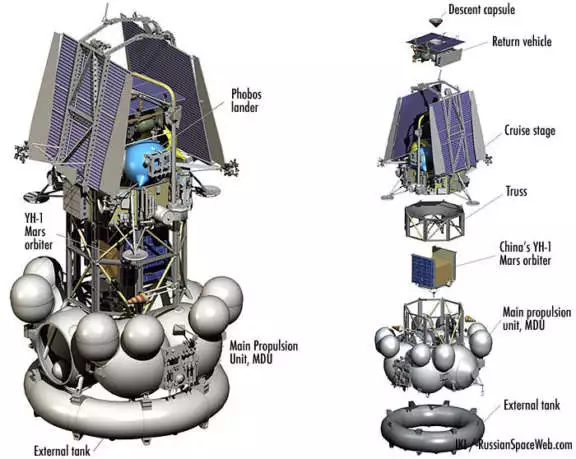
The failed Fobos-Grunt mission (Image Credit: www.planetary.org)
Yinghuo-1, literally meaning ‘Luminous Fire’, was 115 kg orbiter with an intended life in orbit for about 2 years to carry out studies on the red planet’s surface, atmosphere and the magnetic field using the onboard optical imaging system, fluxgate magnetometer, radio-occultation sounder and a plasma package, consisting of an electron analyzer, ion analyzer and mass spectrometer.
After being stranded in the parking orbit, CNSA declared the Yinghuo ‘lost’ on November 17 and the spacecraft was destroyed on re-entry into the atmosphere in January 2012.
Mission Planning
Initially scouting the Chryse Planitia and Elysium Mons regions for potential landing sites, CNSA announced at a joint meeting of the European Planetary Science Congress – Division for Planetary Sciences, in Geneva about two potential sites in Utopia Planitia. Each of these sites had a landing ellipse of approximately 100 x 40 km.
The Tianwen lander propulsion system consists of a single-engine capable of providing 7500 N of thrust, developed and tested by Xi’an Aerospace Propulsion Institute, a subsidiary of the main contractor, namely the China Aerospace Science and Technology Corporation.
The systems underwent multiple checks to assess their performance for hovering, hazard avoidance, deceleration and landing.

Tests being carried out on the lander at a specially developed testing site in Heibei (Image Credit: jagranjosh.com)
The launch vehicle Long March V also successfully underwent a hydrogen-oxygen engine 100 seconds test prior to the launch. Apart from this, the Beijing Institute of Space Mechanics and Electricity carried out multiple landing simulations.
CNSA announced its intention of landing in Utopia Planitia in July 2020, providing the coordinates 110.328o E and 24.748o N as the primary landing site.
Scientific Objectives
With the primary objective of validating CNSA’s Deep Space Communication and Control Technology, the mission had five scientific objectives.
- Study the geological structure of Mars and that structure’s historical evolution and analyze topographical data from characteristic regions such as dry riverbeds, the reliefs of volcanoes, glaciers at the poles and areas affected by wind erosion.
- Study the characteristics of both the surface and underground layers of Martian soil and the distribution of water ice.
- Study the composition and type of rocks on the Martian surface, carbonate minerals present in ancient lakes, rivers, and other landscapes resulting from the past presence of water on the planet, and weathering minerals such as hematites, lamellar silicates, sulphate hydrates and perchlorate.
- Study the ionosphere, the climate, the seasons, and more generally, the atmosphere of Mars, both in its near-space environment and on its surface.
- Study the internal structure of Mars, its magnetic field, the history of its geological evolution, the internal distribution of its mass, and its gravitational field.
The Zhurong is primarily a technology demonstrator which will collect soil and rock samples for further analysis. CNSA intends to recover the Zhurong during future Mars missions with the orbiter constantly monitoring and marking the landing site.

An exhibition model of Zhurong (Image Credit: www.collectspace.com)
Payload and Scientific Equipment
The orbiter and the rover had multiple scientific pieces of equipment on board to collect and process data.

Tianwen’s Martian Landing (Image Credit: Astronomy Trek)
The Zhurong consisted of RoPer Ground Penetrating Radar with a capability of imaging up to 100m below the surface. Along with RoPer was the RoMAG, a Surface Magnetic Field Detector and the MCS/MMMI, the Mars Climate Station/Martian Meteorological Measurement Instrument with a thermometer, anemometer and a host of other sensors for monitoring environmental parameters.
A MarSCoDe, a Mars Surface Compound Detector, MSCam Multi-Spectrum Camera and NaTeCam Navigation and Topography Camera were also a part of the rover.
The orbiter carried a set of Medium and High-Resolution Camera, a Mars Magnetometer, a Mineralogy Spectrometer, Orbit Subsurface Radar, Ion and Neutral Particle Analyzer apart from an Energetic Particle Analyzer.
Tianwen Timeline
Developed by China Aerospace Science and Technology Corporation and coordinated by the National Space Science Centre, Beijing, the mission was approved in 2016.
After three years of developmental activities, experts and diplomats were invited to witness the obstacle avoidance test of the rover at the Extraterrestrial Celestial Landing Test Site, marking the spacecraft’s first public appearance.
Formally named ‘Tianwen’ meaning ‘Questions to Heaven’ in April 2020, the spacecraft was catapulted into space atop a ‘Long March V’- the Chinese Heavy Lift Vehicle.
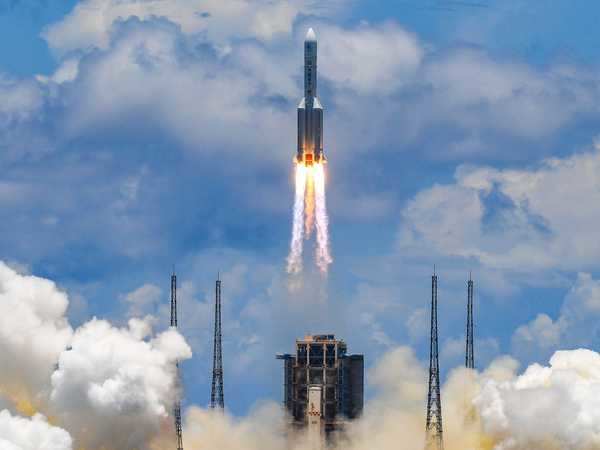
Launch of Long March V, carrying Tianwen-1 en route to Mars (Image Credit: Business Insider)
September 2020 marked the deployment of a Deployable Camera, a small module with two cameras with the objective of photographing the spacecraft and testing the communication equipment.
The landing attempt began on 14 May 2021. Nine minutes after successfully entering into the Martian atmosphere along with the Aeroshell, the Zhurong landed in the Utopia Planitia region of Mars, bringing China the coveted ‘soft landing’ badge, all after a nerve-wracking ‘7-minutes of terror’.
Utopia Planitia is a vast Martian plain, and it is the same spot where the American Viking 2 landed in the 1970s. Further adding to the excitement is the fact that Utopia Planitia is home to a shipbuilding yard in ‘Star Wars’.
The rover descended onto the Martian surface after undergoing a series of system checkouts. Powered by solar panels, the rover will look out for biomolecules and other vital signatures of life in the Martian environment.
Soft landing on Mars can be a tremendous engineering challenge. Not only do they call for heat shielding, thrusters, soft landing also requires the designing and integrating of supersonic parachutes.
Exploration Activities
At 8:10 am IST on 22 May 2021, the Zhurong rolled out onto the surface of Mars. With the capability of exploring the Martian surface for 90 solar days, the Martian rover stands at about 1.85 m in height and weighs about 240 kg.
The first images obtained by CNSA after the landing was that of the empty lander with extended rover-descent ramps.

Images of Martian surface from Tianwen-1 (Image Credit: cdn.cnn.com)
The orbiter will now act as a telecommunications relay and will also parallelly conduct its own set of orbital observations.
Why is Tianwen important?
Mars, our reddish neighbour, has been under the scanner of scientists as potential habitat for the human race in the near future, and this is what makes the Tianwen mission so significant.
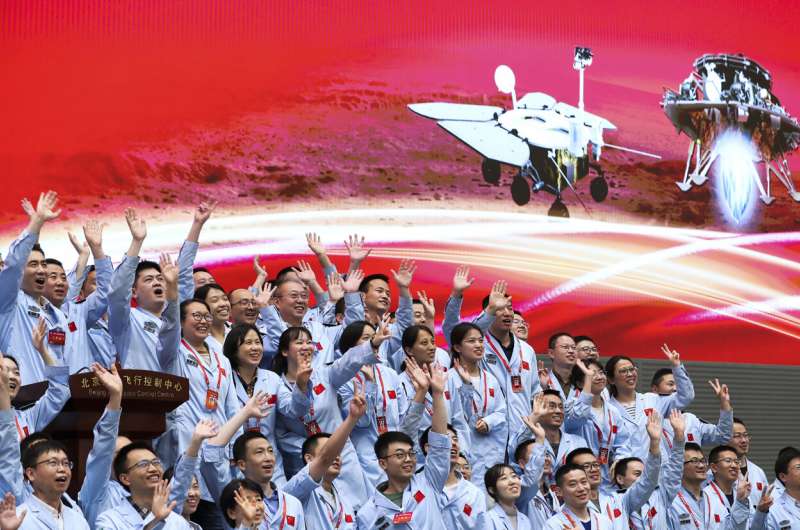
(Image Credit: phys.org)
Tianwen provides China with valuable experience in handling complex interplanetary missions and validates their deep-space communication and control technologies.
China also plans to bring back the rover Zhurong later this decade, retrieving samples of Martian soils and rocks for further analysis. Despite miniaturizing multiple scientific types of equipment specifically for the spacecraft, their accuracy and precision are far lesser than the terrestrial laboratories.
Suggested Reading: China’s permanent space station-A rival for the ISS?
Author
K Shreyas Suvarna
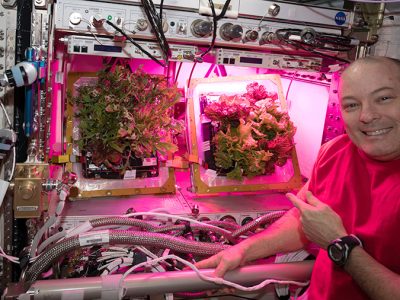


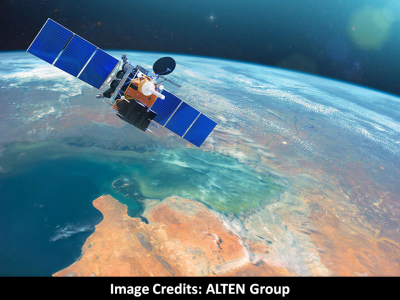









[…] Suggested Reading 1: Tianwen 1: Asia’s first soft landing on Mars […]
[…] Suggested Reading: Tianwen 1: Asia’s first soft landing on Mars […]